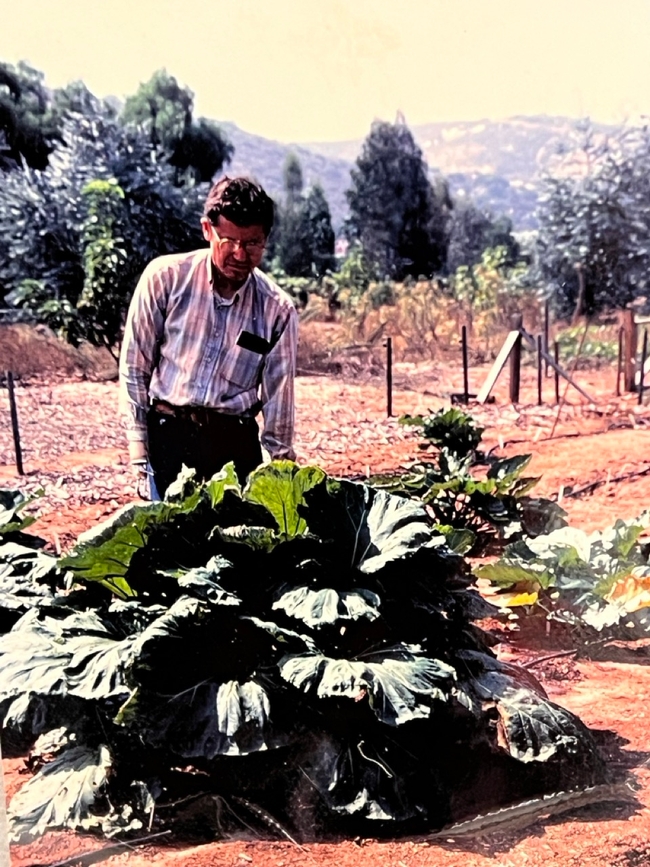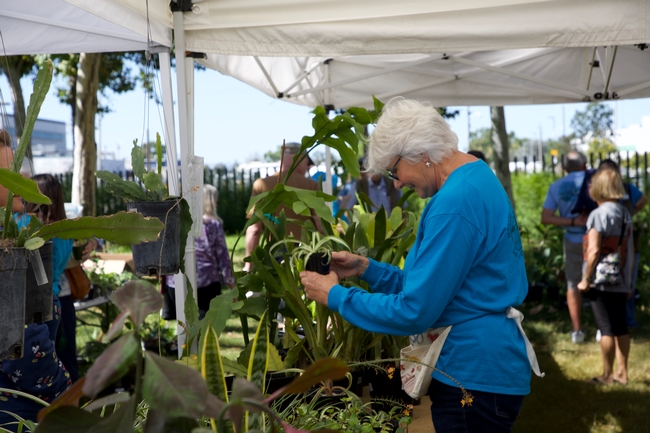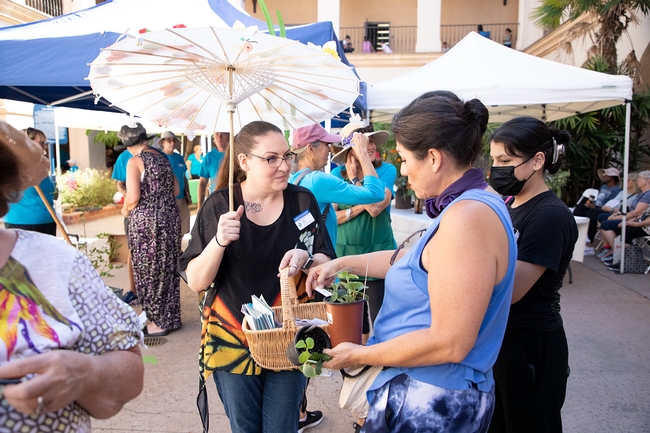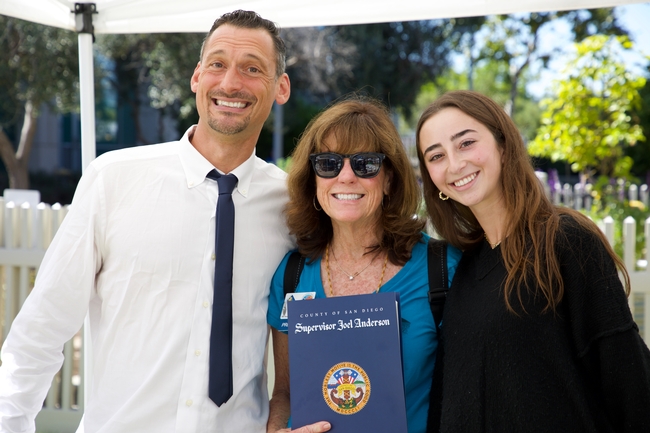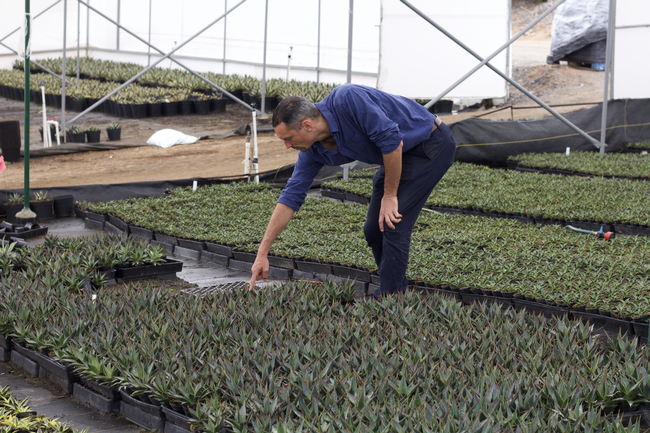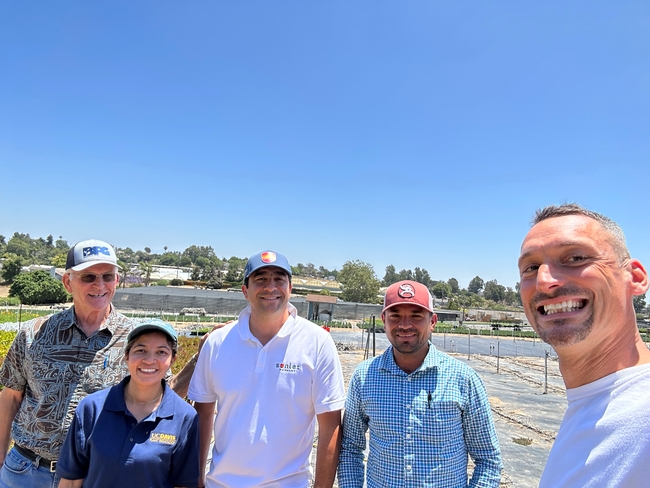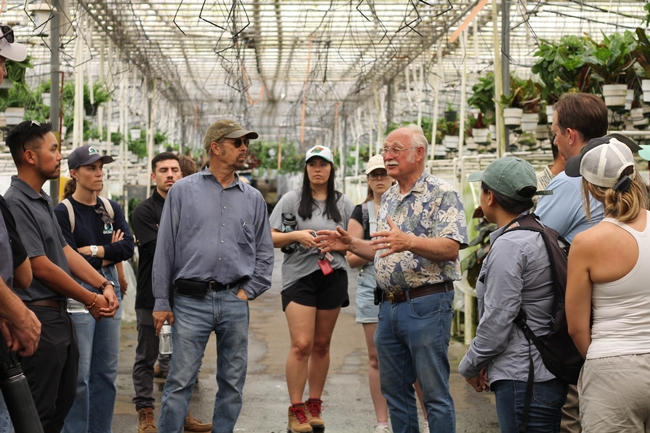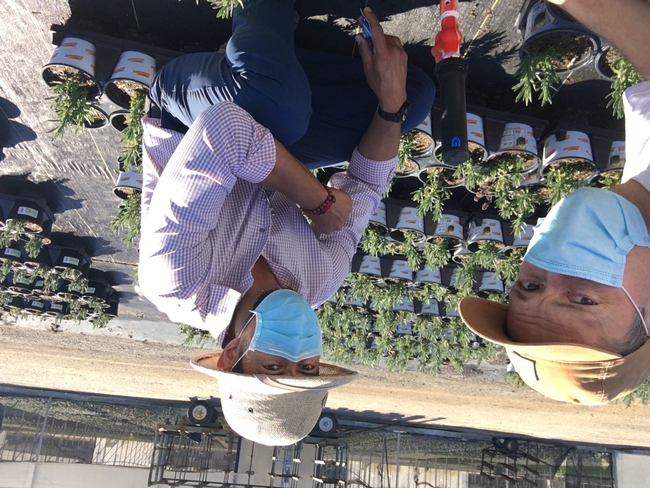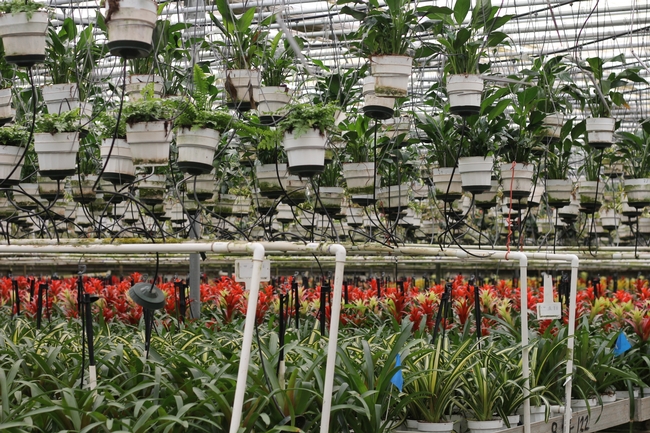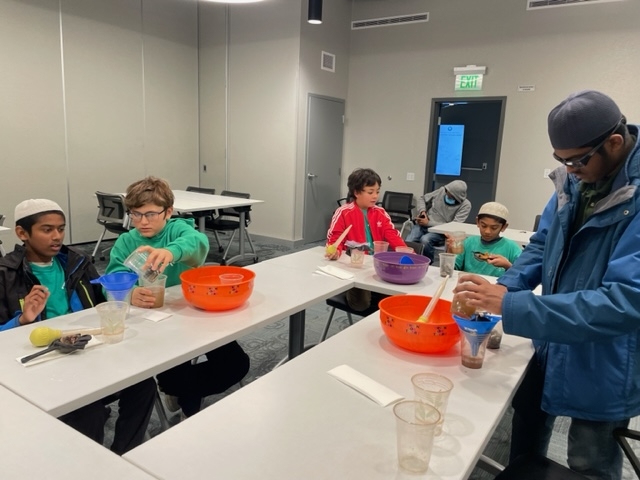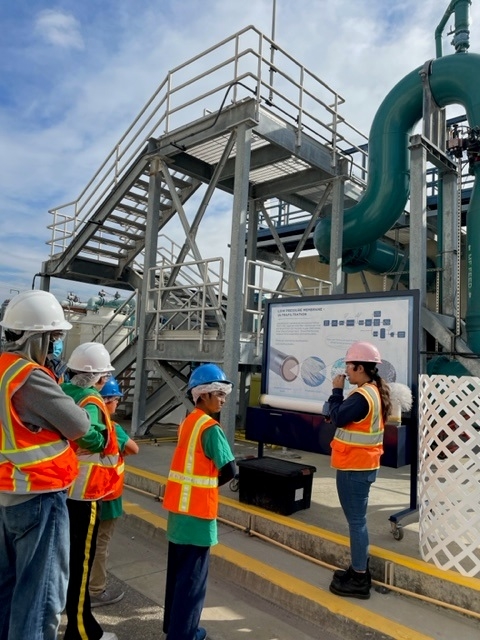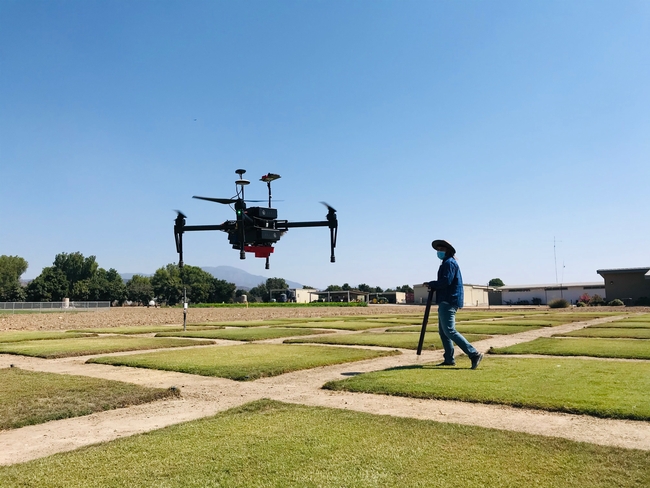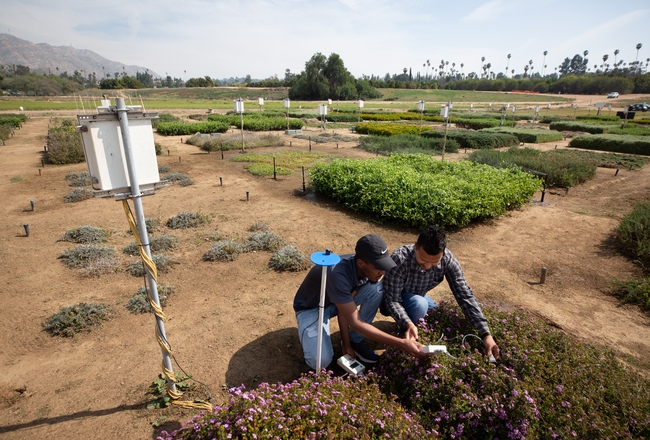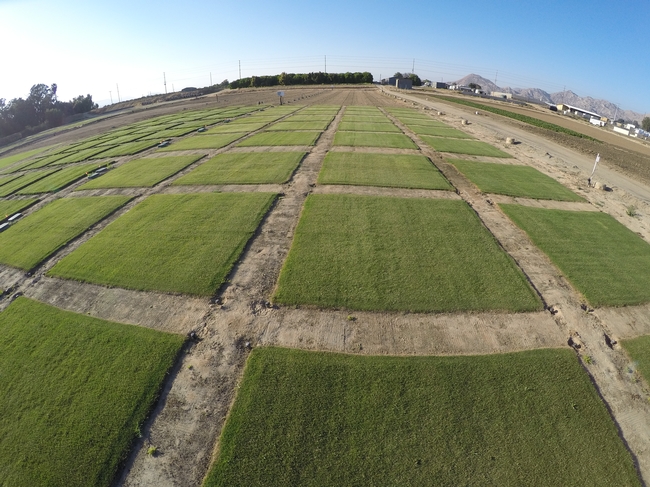Posts Tagged: southern
UC Master Gardeners of San Diego celebrates 40 years of service to community
For 40 years, the University of California Master Gardener Program of San Diego County has upheld its mission of providing research-based information about home horticulture and pest management to the public, while earning and sustaining the community's trust in doing so.
“People trust UC Master Gardeners to provide accurate advice on gardening because they are trained by UC ANR [UC Agriculture and Natural Resources],” said Vincent Lazaneo, emeritus urban horticulture advisor and the first UC Master Gardener program coordinator for San Diego County.
The UC Master Gardener program, a public service and outreach program under UC ANR, is administered by local UC Cooperative Extension offices and outreach is provided by trained volunteers. In 1983, the UC Master Gardener program of San Diego County started with about 30 volunteers. Today, more than 350 volunteers serve the program, which is now managed by program coordinator Leah Taylor.
In San Diego, UC Master Gardeners have had a significant presence in schools, where they encourage an appreciation for plants and our planet; at the county fair where they field hundreds of questions related to plant care; and in community spaces such as Balboa Park and the Carlsbad Flower Fields where they staff demonstration gardens.
“Having the UC behind us is huge,” said Anne Perreira, UC Master Gardener and current president of the Master Gardener Association of San Diego County. “It opens doors for us and gives us credibility.”
'Dual citizenship' status expands capacity for support
When Lazaneo started the UC Master Gardener program in 1983, he felt the need to establish a formal association or 501(c)(3) nonprofit organization that would support the program.
Unsure of what the future held, Lazaneo believed that nonprofit status would increase the UC Master Gardeners' flexibility regarding project development, community engagement and financial planning. After 10 years, the UC Master Gardeners of San Diego County were approved as a registered nonprofit organization and became simultaneously known as the Master Gardener Association of San Diego County.
“It can be confusing for people when they hear that we're a UC program and an association,” explained Taylor. “It's like ‘dual citizenship' in a way, and I think the most important thing to know is that our status as a nonprofit and affiliation to UC work in conjunction to not only support the UC Master Gardeners and what they do in San Diego, but their ability to support UC Master Gardener programs in other counties.”
Emphasizing the research-based approach
Taylor, who has been the program coordinator since 2021, said that the UC Master Gardener program is instrumental in extending the work of UCCE advisors. “If you're working on research and you need to get that information out into the public, we've got 350 UC Master Gardeners who are trained and available to communicate on your behalf,” Taylor said.
“For me it's like a multiplier effect: how many San Diegans can I reach by teaching a seminar on small-scale hydroponics? Maybe 20 or 30,” said Gerry Spinelli, UC Cooperative Extension production horticulture advisor for San Diego County. “But how many can I reach by training 20 or 30 UC Master Gardener volunteers on the same topic? Maybe 200 or 300.”
Spinelli, who also advises the UC Master Gardeners for San Diego County, said that the group has been instrumental in data collection and disseminating information to the public, particularly in urban underserved areas.
Lazaneo recalls the UC Master Gardeners establishing a partnership in 1983 with Cuyamaca College in El Cajon. The college's Horticulture Department allowed the UC Master Gardeners to develop a research garden on campus. After setting a perimeter, building a fence, installing irrigation lines and rototilling the soil, the UC Master Gardeners planted different tomato varieties that were used in a statewide study assessing plant performance for home gardens.
In addition to educating and equipping the public, the UC Master Gardeners of San Diego County have contributed to research efforts on specific crops, including the development of a new artichoke variety, Imperial Star, with guidance from Wayne Schrader, former UCCE vegetable crops advisor for San Diego County.
The research garden, which was used for more than a decade, also aided in research efforts evaluating asparagus varieties, horned cucumbers called “Kiwano,” a fruit similar to melon called pepino dulce, sweet peas, rhubarb and many others. Similarly, the research garden has contributed to trials for soil solarization and chemical treatment to control root knot nematodes and expanded understanding of powdery mildew's impact on summer squash.
Evolving with the times
Out of 170 applications, Lazaneo selected about 30 individuals to be a part of the first class of UC Master Gardeners for San Diego County. Carol Graham, who is still active today, was in the original cohort that formed in 1983.
Graham said that “times have certainly changed,” and one of the changes she's noticed since joining UC Master Gardeners is the proliferation of insects. “I don't remember pests being a severe issue when I first started. Now, you've got all kinds of bugs that have moved into the county, causing people to overuse and misuse pesticides,” said Graham.
Graham's 40 years as a UC Master Gardener have given her an opportunity to teach people how to overcome their phobias of bugs and how to use pesticides safely and appropriately. Furthermore, her role as a UC Master Gardener has allowed her to teach others how to grow their own food in hopes of enhancing food security in the county, something she cares deeply about.
The UC Master Gardeners also have changed the way they communicate over the years. DeLayne Harmon, vice president of member services, is well-versed in the program's history.
“Before we began tracking our volunteer hours online, do you know what the UC Master Gardeners did back in the day?” asked Harmon, who joined UC Master Gardeners in 2020. “They wrote everything down by hand, with pen and paper!”
“It's easy to have the mentality that's like, ‘This is how we've always done things,'” said Harmon. “But the UC Master Gardeners know that there is always room for improvement, and we welcome opportunities to be better.”
Giving back and putting people first
The UC Master Gardeners of San Diego County are eager to improve access to fresh food in schools. Recently, the UC Master Gardeners were given a $5,000 grant by the Sage Garden Project, which will be used to partner with schools in under-resourced communities.
“We want to be in places where the people don't know about UC Master Gardeners,” said Perreira, the association president. “We realized that there are a lot of students who don't know what fresh food looks like and we want to change that.”
In 2022, the UC Master Gardeners transformed a landfill into a demonstration garden, now called the Paradise Hills Native Garden, which they also maintain. “It's beautiful and there are walking trails for the community to enjoy,” Taylor said. “The native garden is in a neighborhood that doesn't have a lot of green space, and to have something so beautiful, that encourages community gatherings, it's a good thing.”
Looking to the future of the UC Master Gardener program in San Diego, Taylor says that she wants to continue making an impact in the community and having the UC Master Gardeners be that driving force.
Grateful for Taylor's leadership, Spinelli said that he is excited about the program's impact on food education, particularly in food deserts.
“We are blessed with a climate that allows year-round food production, and with the science-based knowledge offered by the UC system, our UC Master Gardeners can provide San Diego County residents with the tools to grow local, healthy, nutritious, safe and environmentally friendly food for their families,” Spinelli said.
When reflecting on how far the UC Master Gardeners of San Diego County have come, Perreira – who has been a UC Master Gardener since 2016 – emphasized how important it is to continue their legacy of doing good in and with the community. “We've got a diversity of skills within our group and I'm ready for us to expand our capacity to create change. What we do and what we say have to mean something!” she said.
To read this story in Spanish, visit: https://ucanr.edu/blogs/blogcore/postdetail.cfm?postnum=59028
UCCE San Diego advisor educates growers on complex water regulations
‘Ag Order' for San Diego County expected to be enforced by end of 2023
Generally known for its steady warmth and picturesque beaches, San Diego County is also home to nearly 5,000 small farms and is an economic hotspot for nurseries and floriculture. But the great diversity of ornamental crops that dominate the growing region and complexity of regulations make compliance challenging for growers, some of whom grow over 400 crop varieties.
“The regulatory environment for the growers is still complicated and overwhelming because, along with the Regional Water Board, growers are regulated by the County of San Diego,” said Gerardo “Gerry” Spinelli, University of California Cooperative Extension production horticulture advisor for San Diego County.
To help growers with compliance, Spinelli is prioritizing education and expanding growers' knowledge. By partnering with organizations such as the Farm Bureau of San Diego County and the San Diego Region Irrigated Lands Group, Spinelli works to reach more than 1,200 growers, supporting them as they navigate regulatory agencies.
Formally referred to as the Regional Water Quality Control Boards, the Regional Water Board aims to develop and enforce water quality objectives and implement plans to protect the beneficial uses of California's waters.
A unique place to grow in California
About 10 years ago, the Regional Water Board created the Agricultural Order (Ag Order), a set of rules outlining how growers manage water discharge from agricultural operations.
The new Ag Order for San Diego County, expected to be enforced by the end of 2023, will focus on nitrogen management and groundwater quality. However, new considerations are needed to address the variety of crops grown by a single farmer, a common practice in San Diego.
Calculating nitrogen input and output for more than 400 crop varieties is not feasible for small farmers, a challenge exacerbated by the meticulous attention needed for San Diego's high-end specialty crops like ornamentals, native plants and specialty fruit.
Furthermore, many San Diego growers have limited expertise and experience because they are entering agriculture as a second or third career. Many have become “accidental growers” in that they purchased land with a preexisting avocado or cherimoya grove, for example.
To help address these challenges, the grower community is emphasizing the need for more educational opportunities that are accessible and relatable.
Equipping growers through education
Enrico Ferro, president of the San Diego Region Irrigated Lands Group – a third-party entity that manages water sample testing on behalf of growers – has relied on Spinelli's teaching to “bridge the gap” for growers, including himself.
“Gerry has been great because he has expertise in nurseries, but the educational content he creates is relevant to all growers,” said Ferro, who is an avocado and citrus grower in San Diego's North County.
Spinelli, who specializes in containerized production in nurseries and floriculture, has been instrumental in providing technical assistance to growers since he joined Cooperative Extension in 2020.
“I started teaching over Zoom since I became an advisor during the pandemic, and I try to cover different topics for each training,” Spinelli said, adding that he teaches in English and Spanish, making his content more accessible to the grower community in San Diego.
For in-person educational opportunities, Spinelli created the “Last Wednesday” monthly meetings hosted at the Farm Bureau of San Diego County, which brings together growers and other agricultural experts to learn from one another.
“We try to get our information out in creative ways and Gerry is instrumental in that. He's our primary source of really wonderful information delivered in an engaging way,” said Tasha Ardalan, program coordinator for the SDRILG. “He's proactive and is always willing to try new things, too.”
Planning for San Diego's agricultural future
Currently, the Ag Order is modeled around regulations for the Central Valley. As conversations and planning for San Diego County continue, Spinelli is supporting the Regional Water Board with information on nurseries and greenhouses in hopes that the final Ag Order will better serve San Diego growers.
“I'm trying to help others understand how nursery and greenhouse production systems function, and how and why they are different from an almond orchard or tomato field in Fresno,” explained Spinelli.
Michael Mellano, CEO of Mellano & Company, a fresh cut flower grower and distributor in Oceanside, feels the impact of the Ag Order and its failure to account for variability. Growing over 100 varieties of flowers, Mellano said that for several plants there is little scientific research on how much nitrate to apply.
“Farmers want to do a good job. We make mistakes and we try to fix them as quickly as we can, and we try to educate others on what works,” said Mellano, who is also a member of the SDRILG.
Growers like Mellano and Ferro agree that the farming community in San Diego needs to be given the latitude to solve problems within their means, an ability that requires an understanding of San Diego's uniqueness.
“San Diego is significantly different, and we need an Ag Order that is reflective of our differences,” said Valerie Mellano, SDRILG consultant and former UCCE environmental issues farm advisor. “In developing the new Ag Order, there's a huge opportunity for education and research, something that we know Gerry can easily do and continue to support us in.”
Thus far, Spinelli's educational content has reached two-thirds of SDRILG's 1,200 members. In addition to the live training sessions, growers can watch videos that cover topics such as evapotranspiration, irrigation distribution uniformity, water quality indicators and more on Spinelli's YouTube channel.
Since the Ag Order requires all growers to complete two hours of water-quality education, the SDRILG has agreed to apply one hour of credit to growers who attend a one-on-one session with Spinelli.
As San Diego's growers continue to leverage educational opportunities – whether it's alongside Spinelli, SDRILG or learning from one another – Spinelli emphasized that their success also relies on an ag order that adheres to a distinctive landscape, multitude of specialty crops and growers with varying expertise.
Los Angeles 4-H program cultivates future generation of water stewards
Ibrahim Yaaseen, member of the Palos Verdes Peninsula (PVP) 4-H club, grabs a hard hat and places it on top of his head. He then reaches for a bright orange safety vest and goggles to complete his safety gear outfit before joining the rest of his club members who are dressed the same.
The 4-H Youth Development Program of Los Angeles is already thinking about the future of water management and turned to the West Basin Municipal Water District in El Segundo to gain a deeper understanding of the precious resource we often take for granted.
The University of California 4-H Youth Development Program is managed through local Cooperative Extension offices. Through hands-on learning experiences, 4-H empowers youth to reach their full potential and enables them to build self-esteem, connect with their community and emerge as leaders.
Dee Keese, community club leader for the PVP 4-H club, coordinated an exclusive and interactive tour of West Basin's Edward C. Little Water Recycling Facility for the club's monthly marine biology meeting in December 2022.
Eager to inspire a stronger appreciation for water, Janel Ancayan, the West Basin's education coordinator, challenged the youth to build their own water filters using materials including fabric, a strainer, and a funnel. Since no specific directions were given, the activity challenged each student's science and engineering skills, such as carrying out an investigation, designing a solution, and communicating information with team members.
During the tour, students saw firsthand the impressive equipment and essential staff members that help to produce nearly 40 million gallons of recycled water each day. At the end of the day, students left with a deeper understanding of water resources and felt empowered to do their part to conserve water sources.
“We learned that recycling water helps to conserve our limited water supply and improves the environmental condition of our coastal waters,” said Yaaseen. “We ultimately learned a great deal about how to conserve water for future generations and that water conservation is one of the most important elements in combating climate change.”
Though Keese has volunteered as community club leader for 48 years, this is only the second time she has partnered with the West Basin. “I like to mix it up,” she said. “I'm always looking for community organizations and local businesses to partner with because these are places that the kids will likely interact with since they're nearby.”
Regardless, it's leaders like Keese and programs like 4-H that encourage water stewards like Ancayan. “I'm always so humbled and inspired when teachers make it a point to come out and visit our facility. In Southern California especially, [water] is not something we think about,” Ancayan said.
Even in a drought, water continues to flow from our faucets allowing us to shower, wash dishes or water the lawn. It's no wonder why water conservation is not always top of mind, especially for consumers. Educating the public, and targeting the younger generation, however, is a great start to prepare for the future.
West Basin offers a variety of educational programs that focus on different age groups. Many of them involve hands-on learning like the Teach and Test volunteer program, a partnership with the Surfrider Foundation, where high school students test samples of coastal water for bacteria, and then publicly share their findings to contribute to water quality monitoring in the area.
According to Yaaseen, the time spent with Ancayan at the West Basin was “one-of-a-kind” and provided a “golden opportunity” to learn why water recycling facilities are important. Ancayan hopes that her time spent with students ultimately influences them to consider a career in water.
“It's not a glamorous job but I'm really passionate about the next generation of water workers,” she said. “I hope that once they see the engineering, the excitement of these scientists that work in our laboratory and everything in between, that they start to think about water as a future career path.”
For those interested in joining 4-H, visit https://4h.ucanr.edu/Members/
To read this story in Spanish, please visit:
Programas 4-H de Los Ángeles forman a la futura generación de administradores de los recursos hídricos
https://ucanr.edu/blogs/blogcore/postdetail.cfm?postnum=57063
UCCE water management expert helps save water, increase supply in SoCal
Earlier this year, officials in Southern California declared a water shortage emergency resulting in restrictions such as limiting outdoor water use to one day of the week. While mandatory restrictions vary across the region, Amir Haghverdi, UC Cooperative Extension specialist and associate professor of agricultural and urban water management at UC Riverside, is using research to pinpoint irrigation strategies that will help communities reduce their demand for water and increase supply.
Haghverdi and his team are responding to a hotter and drier California by working to identify changes that can make a substantial difference in water savings.
While behavioral changes such as preventing leaks and turning the faucet off while brushing teeth can help, Haghverdi's research focuses on methodical changes like stressing green spaces, planting drought-tolerant plant species, using non-traditional water sources, and investing in technology to better control water use.
Testing a lawn's limits
For six years, Haghverdi and his team have performed stress tests on turfgrass to identify the lowest percent of evapotranspiration rate (ETo) that it can withstand and still survive. To do this, Haghverdi's team applies different percentages of ETo, obtained from weather stations, and monitors the performance of each landscape species over time.
While both cool-season and warm-season species can be stressed and still maintain their aesthetic value for a few weeks to several months, Haghverdi's results showed that warm-season turfgrass species require less water and can withstand water stress better.
The actual duration that people can apply less water depends on the type of turfgrass, the weather conditions and the stress level. For example, results showed that hybrid bermudagrass (a warm-season turfgrass) during summer in inland Southern California could keep its aesthetic value above the minimum threshold for 30 to 50 days, depending on the weather conditions, with irrigation application as low as 40% ETo.
In contrast, tall fescue, a cool-season turfgrass, even with 20% more water, showed signs of stress after only a few weeks and could not maintain its minimum acceptable quality.
Plant drought-tolerant species
Haghverdi's work demonstrates that when water conservation is the goal, alternative groundcover species are clearly superior to all turfgrass species and cultivars that they have tested so far. In fact, his team has identified drought-tolerant species that can maintain their aesthetic values with a third to a quarter less water than cool-season turfgrass (as low as 20% ETo) and can even withstand no-irrigation periods.
Furthermore, extensive field trials showed that new plant species from different regions could be as resilient as native species in withstanding drought and heat stress while maintaining their aesthetic beauty and cool canopy. Occasionally, they have outperformed native species, underscoring the advantages of drought- and heat-tolerant species that are non-native.
Based on Haghverdi's preliminary results for minimum irrigation requirement in inland Southern California, creeping Australian saltbush, a non-native species originally from Australia, and coyote bush, native to California, were top performers. Considering cooling benefits, drought tolerance and sensitivity to over-irrigation, creeping Australian saltbush performed the best.
Counties are already using recycled water
Although he recommends renewing your landscape with drought-tolerant or low-water use greenery and identifying how long your green spaces can live without water, Haghverdi acknowledges that, while contradictory, the cooling benefits of landscape irrigation are essential in Southern California.
“This is one of the tradeoffs of water conservation,” said Haghverdi. “If the only goal is to conserve water, maybe people will conclude that we don't have enough water to irrigate landscape.”
Water conservation efforts could influence counties to stop or reduce landscape irrigation. The consequences, however, would result in hotter environments due to the heat island effect. The loss of landscapes means that the sun's energy will be absorbed into the ground, instead of prompting transpiration in plants, which helps keep environments cool.
Thus, stressing green spaces and investing in drought-tolerant plant species help reduce the demand for water, but increasing water supply is just as vital. Haghverdi urges Southern California counties to prioritize a supplemental water supply such as recycled water – an approach already implemented in Ventura, Orange and San Diego counties.
The Metropolitan Water District of Southern California's Pure Water Southern California Program, formerly known as the Regional Recycled Water Program, aims to do just that. In partnership with the Los Angeles County Sanitation Districts, the program will further purify wastewater to produce a sustainable source of high-quality water for the region.
According to the program's website, this would “produce up to 150 million gallons of water daily when completed and provide purified water for up to 15 million people, making it one of the largest water reuse programs in the world.”
Smart controllers save time, money and water
Making the best use of the water you already have relies on efficiency. Sprinklers that are poorly placed, for example, are not as effective as they could be.
“What I see often while walking my dog in the neighborhood is that there's a lot of runoff, bad irrigation and bad timing like when it's windy,” Haghverdi observed. “People usually set their irrigation timer and then forget it, but they don't adjust it based on the season or weather parameters. That's not going to help us conserve water, a precious resource, in California.”
Thankfully, Haghverdi and his team have done extensive research on smart irrigation controllers, which, simply put, are irrigation timers with a sensor built in. Generally, there are two types of smart irrigation controllers: weather- and soil-based controllers.
Weather-based controllers use evapotranspiration data to automatically adjust their watering schedule according to local weather conditions. Soil-based controllers measure moisture at the root zone and start irrigating whenever the reading falls below a programmed threshold.
Smart controllers that have flowmeters can detect leaks and be activated automatically, whereas rain sensors can stop irrigation during rainfall. Although both additions are ideal for large irrigation landscapes such as parks and publicly maintained green spaces, rain sensors are easy to install and effective for residential areas too.
When asked about cost being a hindrance, Haghverdi responded, “Not a lot of people know that there are grants for smart controllers – some that will pay either all or a majority of the cost.”
To check if grants are available in your area, interested individuals are encouraged to contact their local water provider.
“We need to move towards autonomous and smart irrigation [strategies], and water management in urban areas. That's the future. If we can build autonomous cars, why can't we build smart water management systems that apply the right amount of water to each plant species, can detect leaks and prevent water waste?” said Haghverdi.
To learn more about or stay updated on Haghverdi's research, visit www.ucrwater.com.
Davis Teen: How Those Pesky Mosquitoes Led to a Scientific Publication
Listen to ABC Channel 10 News, broadcast Dec. 22Seventeen-year-old Helena Leal doesn't like mosquitoes, but they like her. “I always get...
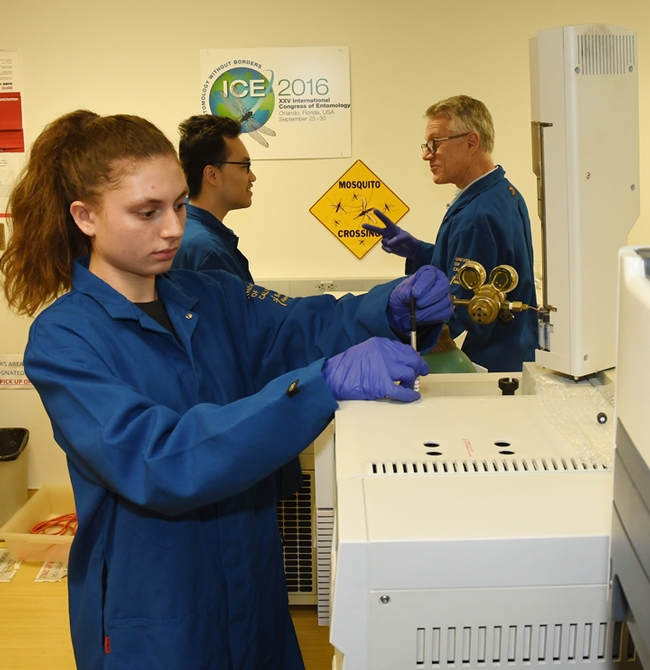
Researcher and lead author Helena Leal, 17, a scholar at Davis High School, injects a sample of odorants trapped in a solid phase micro-extraction syringe intothe gas chromatography–mass spectrometry (GC-MS) in the Walter Leal lab at UC Davis. In back are chemical ecologist Walter Leal (right) and UC Davis student researcher Kaiming Tan. (Photo by Kathy Keatley Garvey)
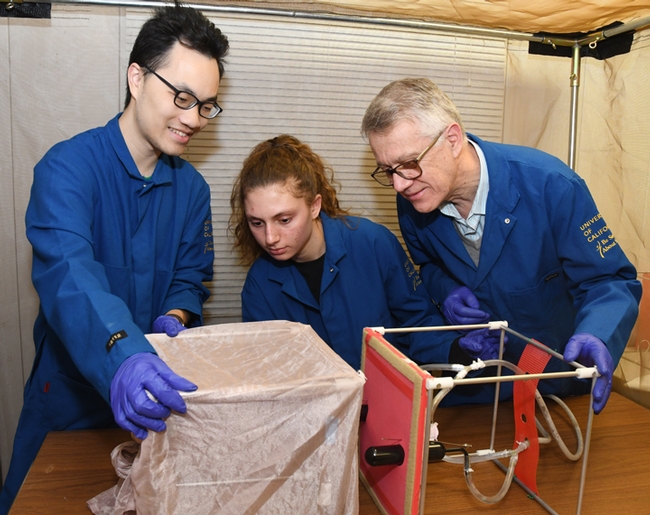
Working on the mosquito cage assay are (from left) researchers Kaiming Tan, a UC Davis student in the Walter Leal lab; lead author Helena Leal of Davis High School, and UC Davis chemical ecologist Walter Leal. (Photo by Kathy Keatley Garvey)
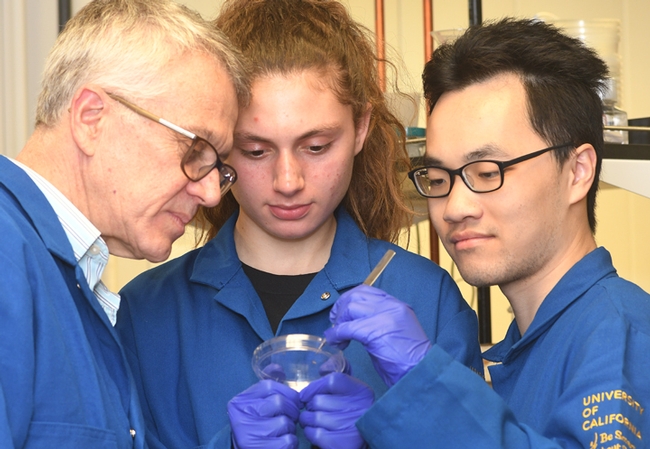
Looking over mosquito specimens are (from left) UC Davis chemical ecologist Walter Leal and two members of the research team: daughter Helena Leal, lead author; and UC Davis student Kaiming Tan. Not pictured is UC Davis student researcher Justin K. Hwang. (Photo by Kathy Keatley Garvey)
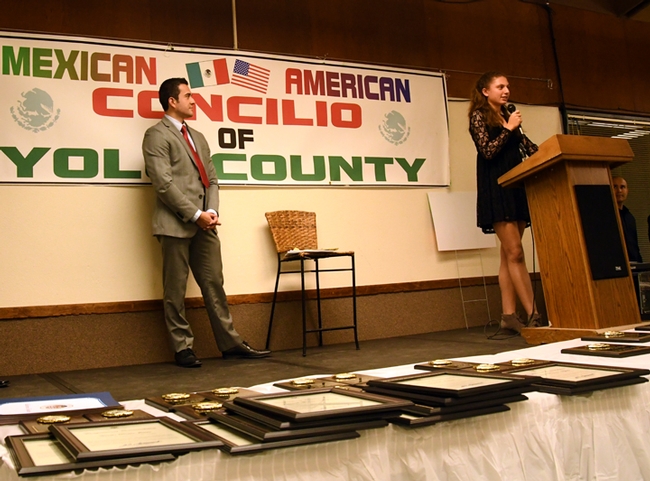
Davis High School scholar Helena Leal addresses the crowd at the Mexican-American Yolo County Concilio Scholarship Dinner. At left is keynote speaker Carlos Saucedo of ABC Channel 10.(Photo by Kathy Keatley Garvey)


